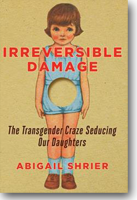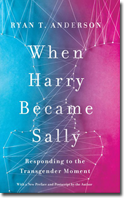Transgenderism has been the topic in the news for more than a decade; therefore, Christians need to know what to think about the various claims being made. We also need to know how to respond to an aggressive push by trans activists to normalize this behavior and criticize anyone who does not accept it.
 Transgenderism is the belief that people have a “gender identity” that is distinct from their biological sex. If they feel there is a conflict between their gender and their sex, gender identity should take precedence. Although a very small fraction of the population may experience gender dysphoria (where a person experiences discomfort or distress from a mismatch between their biological sex and the gender they want to be), the current percentage of Americans identifying as transgender or nonbinary (not identifying as either male or female, masculine or feminine) has exploded.
Transgenderism is the belief that people have a “gender identity” that is distinct from their biological sex. If they feel there is a conflict between their gender and their sex, gender identity should take precedence. Although a very small fraction of the population may experience gender dysphoria (where a person experiences discomfort or distress from a mismatch between their biological sex and the gender they want to be), the current percentage of Americans identifying as transgender or nonbinary (not identifying as either male or female, masculine or feminine) has exploded.
Sexuality, Gender, and Medical Studies
Dr. Paul McHugh has served as the Professor of Psychiatry and Behavioral Sciences at Johns Hopkins Medical School. He has concluded that “gender reassignment surgery” doesn’t work. He, along with Dr. Lawrence Mayer, surveyed over 200 peer-reviewed studies done in various disciplines.{1} Here are four of the most important conclusions from their paper:
First, the “belief that sexual orientation is an innate, biologically fixed human property” is not supported. In other words, people are not “born that way.”
Second, the “belief that gender identity is an innate, fixed human property independent of biological sex—so that a person might be a man trapped in a woman’s body or a woman trapped in a man’s body—is not supported by scientific evidence.”
Third, “only a minority of children who express gender-atypical thoughts or behavior will continue to do so into adolescence or adulthood.” It goes on to say that children should not be encouraged to become transgender. They also should not be subjected to hormone treatments or surgery.
Fourth, people who are homosexual or transgender “have higher rates of mental problems (anxiety, depression, suicide), as well as behavioral and social problems (substance abuse, intimate partner violence), than the general population.”
While the paper only focuses on the scientific research, it obviously has implications for public policy. Incorrect scientific claims have been used to justify court rulings, government policies, and medical practices concerning sexual orientation and gender identity. They have not been based upon sound science.
American College of Pediatricians
Above, we talked about some of the scientific research into homosexuality and transgenderism. Dr. Paul McHugh and Dr. Lawrence Mayer surveyed over 200 peer-reviewed studies and came to conclusions that are contrary to much of the current statements being made by trans activists.
Dr. Paul McHugh was also one of the authors of a statement by the American College of Pediatricians. The title of their statement was: “Gender Ideology Harms Children.”{2}Here is a summary sentence or two of the eight points they make in their statement.
1. “Human sexuality is an objective biological binary trait: XY and XX are genetic markers of health, not genetic markers of a disorder.”
2. “No one is born with a gender: Everyone is born with a biological sex. Gender (an awareness and sense of oneself as male or female) is a sociological and psychological concept; not an objective biological one.”
3. “A person’s belief that he or she is something they are not is, at best, a sign of confused thinking.”
4. “Puberty is not a disease and puberty-blocking hormones can be dangerous.”
5. “According to the DSM-V [Diagnostic and Statistical Manual of Mental Disorders, Fifth Edition], as many as 98% of gender-confused boys and 88% of gender-confused girls eventually accept their biological sex after naturally passing through puberty.”
6. “Pre-pubertal children diagnosed with gender dysphoria may be given puberty blockers as young as eleven, and will require cross-sex hormones in later adolescence to continue impersonating the opposite sex. These children will never be able to conceive any genetically related children even via artificial reproductive technology. In addition, cross-sex hormones (testosterone and estrogen) are associated with dangerous health risks including but not limited to cardiac disease, high blood pressure, blood clots, stroke, diabetes, and cancer.”
7. “Rates of suicide are nearly twenty times greater among adults who use cross-sex hormones and undergo sex reassignment surgery, even in Sweden which is among the most LGBTQ-affirming countries.”
8. “Conditioning children into believing that a lifetime of chemical and surgical impersonation of the opposite sex is normal and healthful is child abuse.”
Gender Dysphoria Research
Abigail Shrier wrote about the transgender craze in her book Irreversible Damage: The Transgender Craze Seducing Our Daughters.{3} In my radio interview with her, she explained that “gender dysphoria” was characterized by severe and persistent discomfort in one’s biological sex. It typically begins in early childhood. In previous generations, it afflicted a sliver of the population (roughly .01 percent) and occurred mostly in boys.
Prior to 2012, there was no scientific literature on girls (11-21) ever having developed gender dysphoria at all. Then the Western world experienced a sudden surge of adolescents claiming to have gender dysphoria and self-identifying as “transgender.”
In 2016, Lisa Littman (an ob-gyn, public health researcher) was scrolling through social media when she noticed a statistical peculiarity. Several adolescents (most of them girls) from a small town in Rhode Island had come out as transgender. In fact, they were all from the same friend group.
She admitted that she knew very little about gender dysphoria, but this statistical anomaly was interesting to her. And she then noticed there had been a sudden spike in the Western World of girls experiencing gender dysphoria. She immersed herself in the scientific literature on gender dysphoria to try to understand what was happening. Perhaps it was due to increased social acceptance of LGBTQ people, but she suggested in a peer-reviewed paper that the girls might be rushing toward “transition” because of peer contagion. As you might imagine, her suggestion was roundly criticized. She was also accused of anti-trans bigotry.
In a subsequent research project, she collected data anonymously from 256 parents whose kids had not met the criteria of gender dysphoria in childhood, but suddenly identified as transgender in adolescence. She identified 16 traits in common. Here are a few.
1. The vast majority have zero indicators of childhood gender dysphoria.
2. Almost a third of them did not seem at all gender dysphoric.
3. A majority had one or more psychiatric diagnosis and almost half were engaged in self-harm prior to the onset of dysphoria.
4. Nearly 70 percent of the teenagers belonged to a peer group in which at least one friend had also come out as transgender.
5. Among parents who knew their children’s social status, over 60 percent said the announcement brought a popularity boost.
6. Over 88 percent of the parents surveyed reported being supportive of transgender rights.
There is growing evidence that social contagion is a much better explanation for the notable increase in the number of young people (especial young women) who now claim to be transgender.
Promotion of Transgenderism
Transgenderism has been promoted through social media, through the schools, and even through the medical establishment. Abigail Shrier began to look at the influence of social media on this transgender craze. In her chapter on “The Influencers” she talks about trans promoters who have become a YouTube sensation. We are seeing similar promoters on TikTok and other social media platforms. Here are a few of the ideas she discovered.
1. If you think you might be trans, you are.
2. Testosterone is amazing. It may just solve all your problems.
3. If your parents love you, they will support your trans identity.
4. Deceiving parents and doctors is justified, if it helps transition.
5. You don’t have to identify as the opposite sex to be trans.
She also found that transgenderism was being promoted through the schools. One program coordinator she talked to acknowledged that the “role of schools has changed.” Now “schools have expanded to be the hub for a lot more social services and looking more holistically, emotionally, at what’s going on with children.” In other words, they have become a “source of social justice.”
You might wonder how schools teach about transgenderism to young children. Teachers begin by talking about gender identity. A book intended for kindergarten teachers to read to their students reinforces the idea that gender is a social construct. It begins with a familiar origin story: “Babies can’t talk, so grown-ups make a guess by looking at their bodies. This is the sex assigned to you at birth, male or female.” It then provides a list of gender options: trans, genderqueer, non-binary, gender fluid, transgender, gender neutral, agender, bigender, etc.
Transgender charts and diagrams are being used in many schools. There is a “Genderbread Person” that is supposed to help children sort through how their gender identity and their gender expression relates to their biological sex. And there is a “Gender Unicorn” that is supposed to help them understand who they may be physically attracted to and emotionally attracted to.
The American Psychological Association has even put together guidelines for the Care of Transgender and Gender Nonconforming (TGNC) patients. Doctors must provide “gender affirming care” which is defined as being “respectful, aware, and supportive of the identities and life experiences of TGNC people.”
How to Respond to the Transgender Moment
Ryan Anderson is the author of the book, When Harry Became Sally: Responding to the Transgender Moment.{4} When I interviewed him on his book, he explained how transgender ideology promotes the opportunity for children to change their gender with surgery and drugs. And parents “are told that puberty blockers and cross-sex hormones may be the only way to prevent their children from committing suicide.”
Ryan Anderson countered that the best studies of gender dysphoria have found “that between 80 and 95 percent of children who express a discordant gender identity will come to identify with their bodily sex if natural development is allowed to proceed.” He also documented that even children going through “transitioning” treatment still have an extraordinarily high rate of suicide attempts compared to the general population.
He reminded us that we should be tolerant and loving toward children (and adults) who struggle with their gender identity. But we should also be aware of the potential harm when transgender identity is normalized.
Unfortunately, we are living in a world where transgender activists want more than tolerance and kindness. They demand affirmation. We aren’t allowed to question whether using medical treatments to aid in transgender transformation is positive for children. In his book, Ryan Anderson shows that the best biology, psychology, and philosophy support an understanding of sex as a bodily reality. As he puts it: “Biology isn’t bigotry.”
Abigail Shrier also offers several suggestions. First, don’t get your kid a smartphone. She explains that nearly every problem teenagers face traces itself back to the introduction of the smartphone years ago.
Second, don’t relinquish your authority as a parent. You don’t have to go along with every idea your teenager has, nor do you have to go along with every educational or psychological fad being promoted in society.
Third, don’t support gender ideology in your child’s education. She provides an example of what happens when schools do a seminar on anorexia or suicide. Often the prevalence increases. A small number of students may have gender confusion or gender dysphoria. But talking about it will spread confusion.
Finally, don’t be afraid to admit, that it’s wonderful to be a girl.
While she talks about the benefits and opportunities of being a girl, Christians can go even further. We believe God is responsible for who we are and what we are. Each one of us is created in God’s image (Genesis 1:26). We can celebrate girls and boys and encourage them to use their gender and their gifts to the glory of God (1 Corinthians 1:31).
Notes
1. Dr. Lawrence S. Mayer and Dr. Paul R. McHugh, “Sexuality and Gender,” The New Atlantis, Fall 2016, www.thenewatlantis.com/collections/sexuality-and-gender.
2. “Gender Ideology Harms Children,” September 2017, https://acpeds.org/assets/imported/9.14.17- Gender-Ideology-Harms-Children_updated-MC. pdf.
3. Abigail Shrier, Irreversible Damage: The Transgender Craze Seducing Our Daughters, Regnery Publishing, 2021.
4. Ryan Anderson, When Harry Became Sally: Responding to the Transgender Moment, Encounter Books, 2019.
©2023 Probe Ministries

 Abigail Shrier wrote about the transgender craze in her book Irreversible Damage: The Transgender Craze Seducing Our Daughters. When she joined me on my Point of View radio program, she explained that “gender dysphoria” was characterized by severe and persistent discomfort in one’s biological sex. It typically begins in early childhood. In previous generations, it afflicted a sliver of the population (roughly .01 percent) and occurred mostly in boys.
Abigail Shrier wrote about the transgender craze in her book Irreversible Damage: The Transgender Craze Seducing Our Daughters. When she joined me on my Point of View radio program, she explained that “gender dysphoria” was characterized by severe and persistent discomfort in one’s biological sex. It typically begins in early childhood. In previous generations, it afflicted a sliver of the population (roughly .01 percent) and occurred mostly in boys. Ryan Anderson is the author of the book, When Harry Became Sally: Responding to the Transgender Moment. He explains how transgender ideology promotes the opportunity for children to change their gender with surgery and drugs. And parents “are told that puberty blockers and cross-sex hormones may be the only way to prevent their children from committing suicide.”
Ryan Anderson is the author of the book, When Harry Became Sally: Responding to the Transgender Moment. He explains how transgender ideology promotes the opportunity for children to change their gender with surgery and drugs. And parents “are told that puberty blockers and cross-sex hormones may be the only way to prevent their children from committing suicide.”
